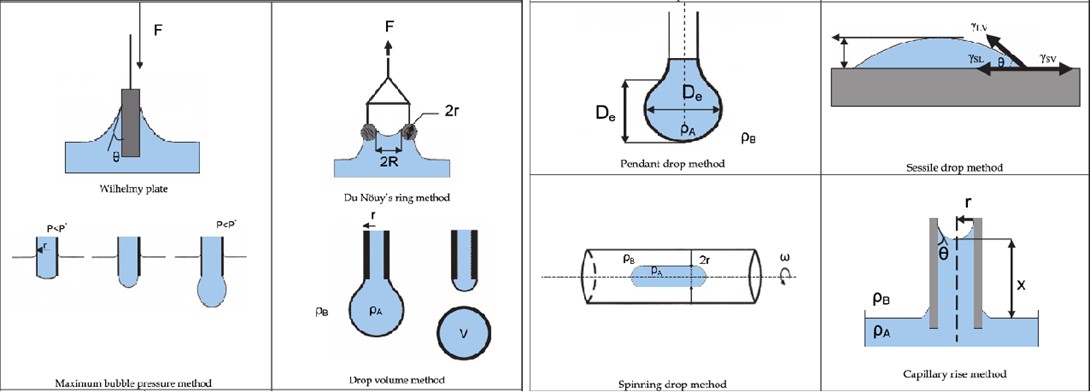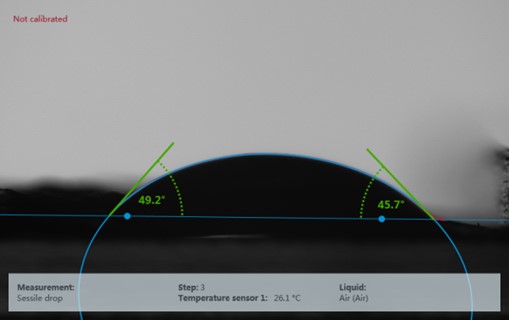Contact Angle and Surface Tension Measurement
Creative Biostructure provides services for measuring contact angles and surface tension, which are key for studying how materials, like proteins and other biomolecules, behave on surfaces. These measurements help us figure out how proteins interact, stay stable, and act in different settings, which is really important when we're analyzing proteins.
What are Contact Angle and Surface Tension?
Contact angle measurement quantifies how a liquid droplet interacts with a solid surface. It is the angle formed between the tangent to the liquid surface and the solid-liquid interface. This angle reveals information about the wettability of a material, with lower contact angles indicating high wettability and higher angles representing poor wettability. Contact angle measurements are critical in understanding surface modifications, coating efficiency, and material hydrophilicity or hydrophobicity.
Surface tension measurement, on the other hand, describes the cohesive force at the surface of a liquid. The surface molecules experience imbalanced forces due to their interaction with the air above them and the bulk liquid below. This imbalance causes the molecules to behave as if the surface is under tension. Measuring surface tension provides insights into the molecular forces within the liquid, as well as how the liquid interacts with its environment.
Why Measure Contact Angle and Surface Tension?
The main purpose of studying surface tension is to determine: 1. The properties of the liquid itself; 2. The impact of the environment on surface tension; 3. The concentration of surfactants with special functions.
Surface tension plays a crucial role in scientific research and industrial applications, especially for functional surfactants like foaming agents, tackifiers, wetting agents, and leveling agents used in various industries (e.g., daily chemicals, inkjet printing, chemical engineering, and cleaning). It is an essential indicator of material surface properties, with broad applications in materials science, chemical engineering, and biomedicine. In biomedicine, measuring contact angle and surface tension is vital for optimizing therapeutic protein formulations, improving drug delivery systems, and enhancing biosensor design by assessing protein adsorption and stability.
 Figure 1. Standard methods of surface tension measurement. (Jouyban A, et al., 2012)
Figure 1. Standard methods of surface tension measurement. (Jouyban A, et al., 2012)
Our Workflow for Contact Angle and Surface Tension Measurement
Using protein solution as an example, we present our workflow for measuring contact angles and surface tension.
- Sample Preparation: Protein solutions and surfaces are carefully prepared to ensure reliable measurements.
- Measurement Method Selection: Depending on the sample's characteristics, we select the most suitable technique, such as the sessile drop method for contact angle or the Wilhelmy Plate Method for surface tension.
- Data Collection and Analysis: We use advanced instruments to collect precise data, followed by detailed analysis using specialized software.
- Comprehensive Reporting: Clients receive a thorough report, including data interpretation and recommendations for optimizing protein formulations or interactions.
- Consultation Services: Our team offers post-analysis consultations to assist with integrating the findings into protein research or product development.
 Figure 2. Static contact angle. (Creative Biostructure)
Figure 2. Static contact angle. (Creative Biostructure)
 Figure 3. Surface tension measurement. (Creative Biostructure)
Figure 3. Surface tension measurement. (Creative Biostructure)
Why Choose Creative Biostructure?
- Specialized Expertise: Our team has extensive experience in working with protein solutions and surfaces, ensuring tailored solutions for specific applications.
- Precision Instruments: We use cutting-edge technology to deliver accurate and reliable data, critical for optimizing protein stability and functionality.
- Customizable Solutions: We understand the unique challenges of protein research and offer flexible testing methods to address specific project needs.
- Rapid Turnaround: We provide timely results to support fast-paced protein research and development.
- Detailed Insights: Our comprehensive reports offer valuable insights into protein-surface interactions, aggregation, and stability.
Frequently Asked Questions
-
Can you measure surface tension for any material other than protein solutions?
Yes, we can measure the surface tension of a wide range of materials, ensuring accurate results that can enhance formulation strategies or applications.
-
How to test the contact angle of fiber samples?
Testing method for fiber samples: The traditional Wilhelmy Plate method (also known as the hanging plate method) is used to measure the surface tension of liquids.
-
What is the difference between surface tension and interfacial tension?
Surface tension of a liquid is measured in air, while interfacial tension is the tension between two immiscible liquids (such as water and oil). There is no interfacial tension between two miscible liquids.
-
What are the main methods for testing surface tension?
Du Nouy Ring method, Wilhelmy Plate method, Hanging drop method, etc.
Creative Biostructure provides high-quality contact angle and surface tension measurement services, utilizing professional technical knowledge to meet the diverse needs of our customers. If you are interested in our services, please contact us for a detailed quote.
Ordering Process
References
- Jouyban A, Fathi Azarbayjani A. Experimental and computational methods pertaining to surface tension of pharmaceutical. Toxicity and Drug Testing. 2012, 47.
- Berry J D, Neeson M J, Dagastine R R, et al. Measurement of surface and interfacial tension using pendant drop tensiometry. Journal of Colloid and Interface Science. 2015. 454: 226-237.
- Guzman-Sepulveda J R, May-Arrioja D A, Fuentes-Fuentes M A, et al. All-fiber measurement of surface tension using a two-hole fiber. Sensors. 2020. 20(15): 4219.

